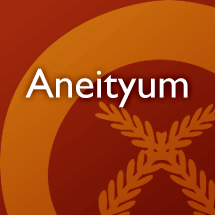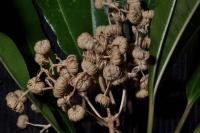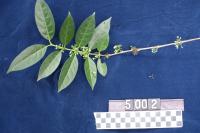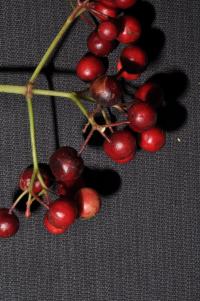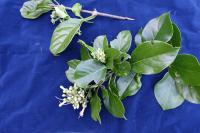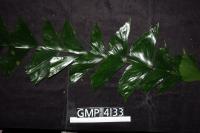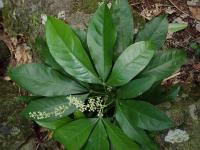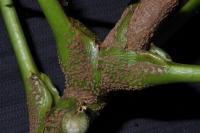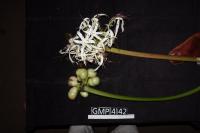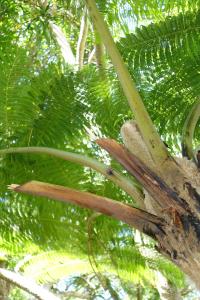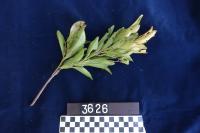Your search for * in botany has returned 100 entries
fetofeto
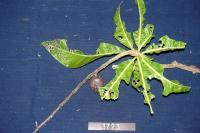
incei u nasuantan

n. subshrub, 0. 5 to 0. 7 m tall (collection: Gregory M. Plunkett #3212)
Example: The common name of this plant means "the plant that belongs to Nasuantan" that being the person who introduced it to Aneityum. He was a person taken from the island as a blackbirder and came back with this plant. It is used for medicine. When a person gets a fresh cut, squeeze the juice from the leaf and put the liquid on the cut to help it heal.
bookmarkink
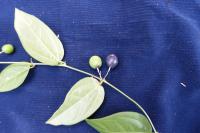
ink
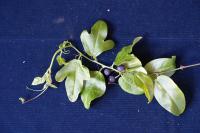
n. vine, growing in coastal forest. Fruits purple. (collection: Gregory M. Plunkett #3556)
Example: A man named Johnnie (Reuben’s grandfather) brought this vine to Aneityum to use it as a rope to tie objects. The ripe fruits are used to paint the face and hands and children make drawings from this dye.
bookmarkink

n. vine, growing in disturbed forest. Fruits green. (collection: Gregory M. Plunkett #3470)
Example: A man named Johnnie (Reuben’s grandfather) brought this vine to Aneityum to use it as a rope to tie objects. The ripe fruits are used to paint the face and hands and children make drawings from this dye.
bookmarkinloptiri
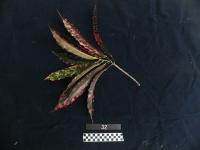
n. shrub. Found in the village Unames. (collection: Ashley A McGuigan #32)
Example: 1. To cure when the anus falls out - Pound together 1 braches worth of inpalcapnesgin leaves and of both inloptiri (2-4 leaves, any age), also take the inner bark of nekeaitimi and nakhe. Put this into your hand, or another leaf and give it to the person to use it. This should be applied to the anus whenever the anus comes out. USed to use a clam shell to extract the bark but not anymore.
bookmarkinmowad itouga
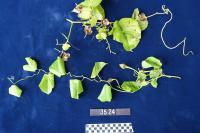
n. vine climbing on Geissois denhamii (GMP #3522), growing in open (collection: Gregory M. Plunkett #3524)
Example: The word itougo means from a different country or place outside of Aneityum. The plant was introduced by the first missionaries who came to Port Patrick. Calendar plant – sea cost people see this flower in the forest and they know it is time to go into garden and harvest taro or make new gardens– see GMP 3263. This is also good firewood.
bookmarkinmowad u pikad
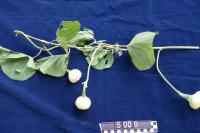
n. vine to 5 m tall in trees, fruits maturing yellow-brown. Growing in agroforest/secondary forest. (collection: Michael J. Balick #5009)
Example: People collect this vine and feed it to pigs. It also has an unspecified medicinal use. The vine of this plant forms a thick canopy so some people plant it around the house near trees that do not give much shade in order to reduce the intensity of the sun on the house and thus keep the temperature lower. The vine grows quickly into the trees.
bookmarkinm̃aka

n. well branched tree, 12 m tall (collection: Gregory M. Plunkett #4022)
Example: 1. A durable hardwood that is used for house posts. 2. The wood is used to fashion cross members that affix outriggers to the body of the canoe. 3. 4-5 inch diameter saplings are used to create a track in the forest that larger logs can roll down.
bookmarkinpakanhas
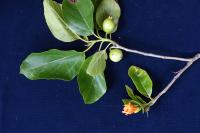
inp̃alanhas
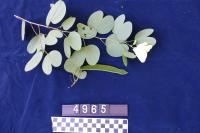
intit plen
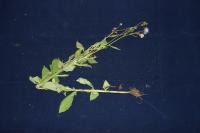
n. herb, growing on roadside in open disturbed area. (collection: Gregory M. Plunkett #3605)
Example: 1a. This is an invasive weed that was brought to Aneityum by aircraft. Name means "aircraft mess". 1b. Means “planes waste” refers to white trails as this has lots of white seeds that fly.
bookmarkintopasyej
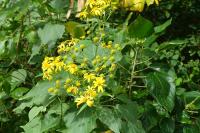
n. shrub to 2 m tall, flowers yellow. Growing along coast. (collection: Michael J. Balick #4959)
Example: The young leaves are boiled for 15 minutes and coconut milk is added to the warm leaves and this is eaten--the coconut milk it said to make the leaves taste better. New mothers are given this food as it helps them to produce more milk for their babies. As a medicine, take the young shoots, peel the outer skin off of these, macerate a 3’ piece of young stem in a small amount of water, take out the fiber, put the juice in a tablespoon and feed it to a baby that is old enough to swallow water (not a new born) when they have diarrhea. Take once daily for 2-3 days. This remedy is used for babies up to one year of age. For older babies that have diarrhea, peel the young 3’ stems and give them to the child to chew (spit out the fiber) and have them drink a small amount of water after chewing. This treatment is once daily, for 2-3 days until the diarrhea stops. For adults, take 4 young stems about 3’ long and chew these and swallow the juice, twice daily (morning and afternoon) and use until the diarrhea stops. When this plant is in flower, hunters know that the turtle has more fat and can be harvested--a calendar plant.
bookmarkintop̃asiej ura
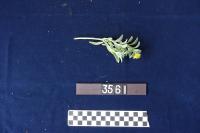
n. stoloniferous herb, 15 cm tall (collection: Gregory M. Plunkett #3561)
Example: In the past the ancestors learned to cook the leaves of this species with fish in an earth over and then eat the leaves as well as the fish. Today, fish are wrapped with small leaves and then covered with lap-lap leaf (Polyscias) and cooked in an earth oven.
bookmarkintoutau
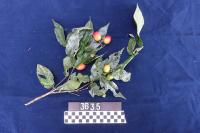
n. tree, 7-8 m tall (collection: Gregory M. Plunkett #3635)
Example: The wood from this tree is used for house posts. Used to heal bad spirits, headaches, fever, or any other kind of illness that modern medicine cannot fix. Must be taken and performed in the evening before the sun sets. Take four leaves from the top of the intoutau, netethae, nelmaha, inrowod plants. Combine them with 1/4 cup of water and squeeze the juice out of the leaves and pour into a piece of bamboo. Give the mixture to the sick person to drink. The woman must drink half of the mixture and use the other half of the mixture to wash their body with. The woman then has to stay away from other people except for those who helped wash her. Then you must smash the bamboo that contained the mixture where the sun sets.
bookmarkinwouse
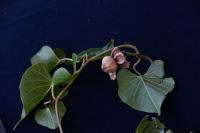
inwowityuwun
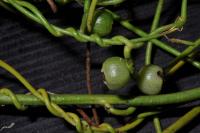
inwowityuwun
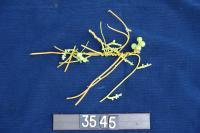
n. parasitic vine scrambling over Scaevola taccada, at edge of strand. Fruits green. (collection: Gregory M. Plunkett #3545)
Example: 1. Take a handful of vine, pound it and wash hair, like shampoo – makes hair curly and like rasta. 2a. This is a "message plant." If a person is walking through a village that is not his, people know that they come in peace. 2b. Message plant - if a group is discussing something and one person goes out and makes a head les of this vine, it means that there can’t be an agreement. 2.) If you are angry at a person, drop the vine at their door, in the case of a visitor or land dispute and they need to leave.
bookmarkinya
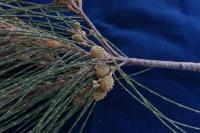
n. large tree, 16 m tall (collection: Gregory M. Plunkett #3222)
Example: 1. As a child’s game, some times children put the segments of the needles together to see who can make the largest one. 2. A "calendar plant"--when the needles are brown, it is an indication that people should not work hard, but should rest or they will not feel well. If they try to work they will feel sleepy--an indication of the season of higher heat. 3. Wood is used as firewood. 4. Firewood, inner bark good for ciguatera poisoning, scratch the inner bark and squeeze juice into a cup of water and give to the sick person to drink – very effective. Use the largest most mature part of the stem.
bookmarkinyacelcou

n. vine running many meters long over clay soil and grassy area on hillside where the triangular wooden signs are that used to be a landmark for ships coming to the island. Sterile. (collection: Michael J. Balick #5008)
Example: This plant is the focus of an important legend on Aneityum. When the missionary John Geddie and colleaguse first arrived on the island in July of 1848, the Chiefs welcomed them but some of the people did not like the idea. So these people sent a basket containing a peeled coconut and a fish (nopom) to the Chief in Umej to ask him to support the idea of getting rid of the missionary that the Chief of Analcahuat had welcomed. If the Chief of Umej were to eat the fish and coconut meat, it would mean that he agreed with the opposition. The Chief refused to eat the food in the basket and he told the people a parable involving this plant. A person cannot find the tip of the stem or the end of the root in the ground. So if they were to eliminate the missionary, his activity would continue because of God’s power. As it is with this plant, it will continue to grow and flourish if you cut it or try to dig up the root. So he sent a message about this plant to the people in Analcahuat who objected to the presence of the missionary stating this parable. Those people in Analcauhat held a secret meeting and they chose a powerful and strong person to kill the missionary. During the night the person went to the missionary’s house while he was in the toilet. Returning to the house, the missionary found the person in his doorway, and that person lifted his club to strike the missionary. But at that point the attacker’s hands suddenly had no power and the club fell from his hands, and he fell over. The missionary told him to get up, and not come back. After that experience, the people of Umej realized that God’s power was great and they could not go against it. The Chief took the peeled coconut that was sent him and covered it with the skin of another coconut and planted it instead of eating it. This coconut grew and the missionary’s work continued to grow on the island. So this vine played an important role in communicating the power of God to the people of Aneityum.
bookmarkinyat
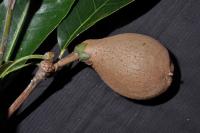
inyiivac
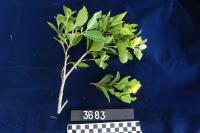
inyiriñwei
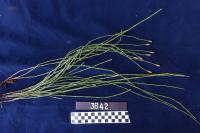
n. herb, growing along the river at the edge of secondary forest. Stems pale green. (collection: Gregory M. Plunkett #3642)
Example: As a local toothbrush, take two pieces of stems, bend them and use to brush teeth with water. This plant acts like sandpaper to clean the teeth. Can also be used to brush pots.
bookmarkinyje
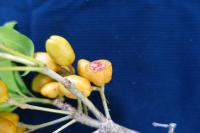
n. tree to 15 m, dbh 20 cm (collection: Michael J. Balick #4914)
Example: Use the leaves to make compost to be placed at the bottom of the hole where taro is to be planted, cover with soil and grow the taro in that hole. Serves as a fertilizer.
bookmarkiñytuplec
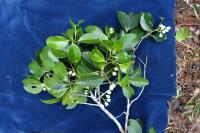
kidie ~ kithi

n. shrub, 1. 5 m tall (collection: Gregory M. Plunkett #3205)
Example: 1. Plant this tree at each of the four corners of a fence to keep your pigs in and protect against a type of bad luck. If a man sleeps with his wife who is having her period, and then the man goes to see the pig, the pig will suffer and not grow strong and not have many piglets. So the presence of this plant controls against bad luck that others can bring to your pig farm. 2. This is an ornamental plant grown around the home. Sticks of this plant are planted around the outside of the garden and grow to create a fence, to protect the crops and keep them healthy, as well as protect the crops from people that are not cleansed in the ritual way. 3. This species is also planted around the house to add color and is very decorative in general. 4. For fertilizer in taro holes for water taro. For baly(?) taro and water taro, lay these flat on the surface of the charcoal, then lay the food – taro, cassava – on this and cover with another layer, add hot stones and cook. 4. Pig food, goat food.
bookmarkmaputu-ligighap
n. the stem of a coconut leaf used for a butt
bookmarknaero

n. sapling directly under large tree of same species (20-25 m tall), growing in primary forest. Sterile. (collection: Gregory M. Plunkett #3451)
Example: 1. Wood used for timber boards. 2. Timber tree, sawn timber young stems for spear fishing, clean bark, heat it, affix tips on the end.
bookmarknaerumãn
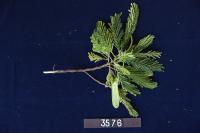
nagatia
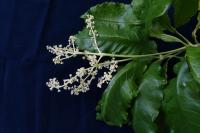
n. treelet 2. 0-2. 5 m tall, dbh 3 cm (collection: Michael J. Balick #4858)
Example: If a chief passes away, they are burred in a sacred place. After burial, the people wash their hands with these leaves, mixed with water. The chiefs have a spiritual power and this is used to cleanse the people attending the funeral so that they do not get large sores on their leg or elsewhere on their body. This is part of the ritual for burying the chief.
bookmarknaha
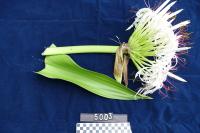
n. herb to 1 m, flowers white (collection: Michael J. Balick #5003)
Example: The leaves are used to wrap fish for cooking in an open fire. If you eat a bad fish and begin to feel the effects of it a few hours later, such as with Ciguatera illness, cut the base of the stem of this plant and let the sap drip into a half coconut shell with coconut water in it, drink the shell and it will make the person vomit out the bad food. It does not taste good but is very effective in making a person vomit as it contains a toxic compound.
bookmarknahoacen
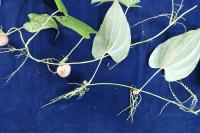
n. vine to 3-4 m, aerial tubers brown (collection: Michael J. Balick #4872)
Example: Normally these fruits are considered poisonous. But, people have learned to peel off the skin of the fruits, put the peeled fruits in a conical basked and place a bamboo tube that is dripping water over it to wash the basket of fruits for 3-5 days. This is said to leach out the poison and the end result is similar in consistency to cheese. Wrap this up with leaves and put it in an earth oven to cook. This plant is eaten as a "starvation food" only, consumed in times of drought and famine.
bookmarknahoj
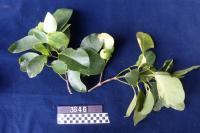
n. tree, 7 m tall (collection: Gregory M. Plunkett #3646)
Example: The ripe fruits of this species smell very nice and people eat the inside part, which tastes similar to a banana. When fruit is ripe the outside is yellow and the inside is purple. The wood can be used for poles to make house rafters. When kids go fishing for shrimps they use the fruit to catch the shrimp by throwing the shrimp into the water which attracts the shrimp.
bookmarknahojcei
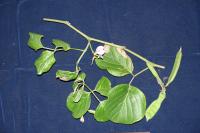
n. scrambling vine, growing in coastal strand vegetation. Flowers purple. (collection: Gregory M. Plunkett #3436)
bookmarknaipomyiv ~ naipomñiv
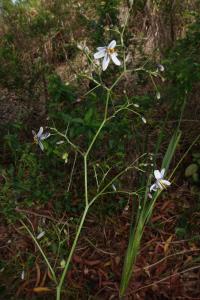
nairo
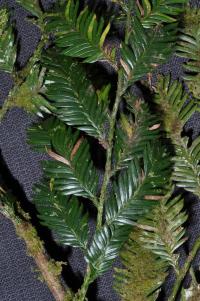
n. sapling, 3 m tall (collection: Gregory M. Plunkett #4106)
Example: 1. Sapling wood is used to make fishing spears. A straight sapling is first heated in the fire to render it pliable. The sapling is further straightened and then decorticated. Once cooled, wire can be added a prong to the end of the spear.
bookmarknala
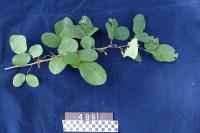
n. shrub to 2 m, coastal vegetation (collection: Michael J. Balick #4961)
Example: The stem of this plant is used for firewood. If a person has been drinking kava and the next morning feels hung over, they can take a handful of the leaves of this plant, crush them in cool water, and wash their face with this. This treatment will help the kava feeling to disappear.
bookmarknamaunirij
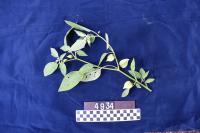
n. herb to 30 cm, fruits green. (collection: Michael J. Balick #4934)
Example: Take the leaves, squeeze out the juice in a cup of water, drink 3x daily for 3 days to treat dengue fever--use one handful of leaves in a cup of water and drink cool. The fruits are edible. Peel the outer part off and eat like a tomato.
bookmarknamji
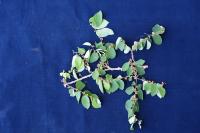
n. tree, 4 m tall (collection: Gregory M. Plunkett #3508)
Example: 1. The stems of this plant are sharpened and used to plant swamp taro or dry land taro. 2. Break small branch top put behind ear if you go to an unknown place and keep behind ear and sleep with it. If the place is safe you will sleep if it is not you will not sleep well – only behind ear when you sleep.
bookmarknamlau
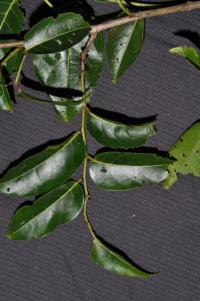
namou
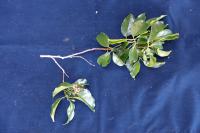
nanad

napalhat
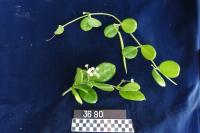
n. vine, growing on rocks at end of strand near coastal forest. (collection: Gregory M. Plunkett #3690)
Example: As a medicine to treat toothache, the latex from this vine is put into the tooth as soon as the person feels pain. Use 3x daily until the pain has subsided. The flower is used as a decoration behind the ear. When there are rough seas because someone has trespassed in a tabu area you can take 12 leaves from the napalhat and put them in a pond for about 1 week until they start to stink. Then use we leaves from the naojapdak and drown those leaves in either a fresh water pond or salty water. (No further information given). Can also take an armful of napalhat and place on top of a stone in the tabu area with a smaller stone on top of the napaphat. The stone must be a large permanent stone. Has also heard people say it can be used for toothache if you put the leaf on the tooth.
bookmarknapapotan
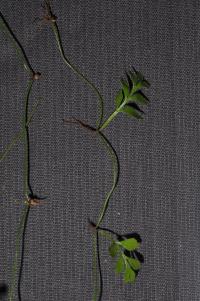
napjau
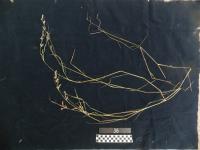
n. grass. Found along intra village path. (collection: Ashley A McGuigan #35)
Example: 1. Bath for babies to make them healthy and walk faster, mix with plants WAKAS (AAB 34), NITIDEI (GMP 3658 or 4043), and a grass NATUTAHUT (MJB 4945). Put all in a kettle filled of water and wash them with it – use 1 handful of each leaf.
bookmarknapleañ
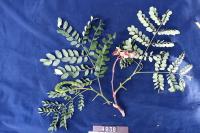
napod
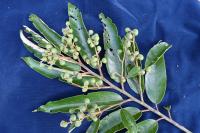
n. tree to 10 m, dbh 30 cm (collection: Michael J. Balick #4900)
Example: Before there was soap, people took the young leaves and crushed them on a stone to make suds for washing clothes in the river. This tree has a very hard wood and can be used for house posts. The sap is reddish and the bark boiled in water until it is red, consumed 2-3 times daily (1 cup each time) until the person feels well. The condition treated is that when a menstruating woman has sex with a man, and he feels tired and lethargic, drinking this tonic makes him feel stronger.
bookmarknap̃at
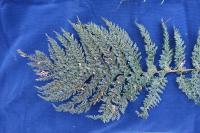
n. terrestrial fern, growing in dwarf cloud-forest. (collection: Gregory M. Plunkett #3268)
Example: For performing a weather magic ritual to produce fog, this plant is fermented along with another plant (nirid u numu) in a hole in a sacred stone (called "Naemoso") at a secret location on Aneityum.
bookmarknap̃od
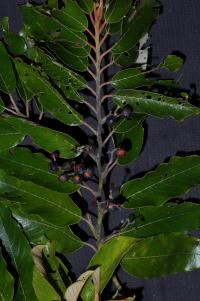
narasincai
n. bark
bookmarknatiñpece
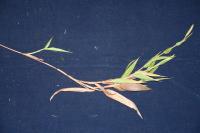
nau
n a plant, with upright clumping. (collection: Ashley A McGuigan #25)
Example: 1. To cure the sea snake (nispev) curse that causes missed periods. First the husband must combine 4 young leaves of incispev and 4young leaves of nafanu and mash and squueze the juice into a small bamboo (1-1.5 inch diameter) The nafanu is important because it is a plant that connects to the sea. Use wildcane leaves cover the bamboo closed. Go to the sick person and unwrap the snake from her. Start from the top and let the woman drink a small part of the potion then wash her with the mixture, making sure to wash head, elbows, knees, feet, and belly. Then take a leaf of naha and break it over
bookmarknau hos

n. a kind of bamboo (collection: Ashley A McGuigan #25)
Example: 1. To cure the sea snake (nispev) curse that causes missed periods. First the husband must combine 4 young leaves of incispev and 4 young leaves of nafanu and mash and squeeze the juice into a small bamboo (1-1.5 inch diameter) The nafanu is important because it is a plant that connects to the sea. Use wildcane leaves cover the bamboo closed. Go to the sick person and unwrap the snake from her. Start from the top and let the woman drink a small part of the potion then wash her with the mixture, making sure to wash head, elbows, knees, feet, and belly. Then take a leaf of naha and break it over the woman’s belly button to break the snake off. Smash the bamboo vessel to pieces. Leave the woman there until the wash dries on her. This takes one whole day and the ceremony in the evening so she can sleep and she must not eat. This ritual is performed by men. 2. To make house walls cut to length desired break stems into straps and weave ??. 3. Use stem to cook foods. 4. Container for carrying water. 5. Take tips and tie together and make a torch to go fishing on the reef, walk with the torch – this is a current practice in the East side. 6. Can cut a piece about 1’ long and sharpen edge and use to skin a green banana. 7. Traditional medicine – can use a small segment as a sort of container to carry the traditional medicine to the patient – for example when prepare a sea snake for remedy, or any medicine – to carry it. 8. Used as a container to preserve seeds such as corn, cucumber, beans and is covered with coconut fiber and put near (above?) the fire where it is dry, and the smoke from the fire will keep insects from attacking the seeds.
bookmarknauhap̃ apeñ
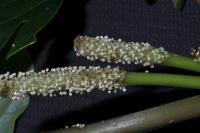
naytmas
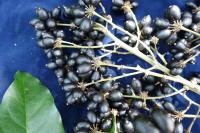
n. tree to 5 m, dbh 4 cm (collection: Michael J. Balick #4898)
Example: The leaves are used to cover goat or pig meat when a person is roasting it on an earth oven It prevents it from burning and enhances the taste of the meat.
bookmarknecemas
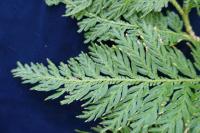
n. fern to 30 cm, cones green (collection: Michael J. Balick #4919)
Example: Use this plant to send a message to someone that another person has died. Take 1 dried leaf, to pass message to another village/tribe or people. Hold it in your hand and walk past a person, then they know that someone has died.
bookmarknecrakiti
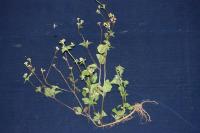
n. herb, growing at edge of garden area. (collection: Gregory M. Plunkett #3601)
Example: This is a "calendar plant". In winter months, if a person sees this plant in flower it is confirmation that the sea turtle has plenty of grease or fat and is good to eat. As a medicine for a cut, collect some leaves, mash them and squeeze the juice on a cut or sore on the body. Do this treatment 3x daily until the sore dries up or the cut heals.
bookmarknecsap̃
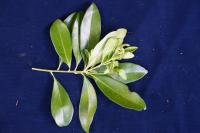
n. shrub, 2 m tall (collection: Gregory M. Plunkett #3534)
Example: This tree has very hard wood. 1. Use the small stems to plant dry land or swamp taro, sharpening the end and pushing it into the ground to make a hole. 2. It also is useful for fence, posts for houses. 3. Small stems are also used to make a comb for the hair. 4. Plant pole for taro kava. 5. A branch is shaped and used to husk coconut. 6. The wood is hard and in ancient times people would take a forked piece and put string on one side of it, sharpen the other side and use with the string as a fish hook – need to keep rope tight until it is in the canoe. Do not give it slack – strong use AAM 17.
bookmarknecyak
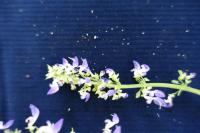
n. herb to 20 cm, flowers blue. (collection: Michael J. Balick #4922)
Example: Roast the tuber of this vine on an open fire for 20-40 minutes, peel off the skin and eat like cassava or taro. Chew it and drink the "juice" while spitting out the fiber. It grows wild, season of harvesting is in May. Very tasty food for people, considered "numba wan" food for this island.
bookmarknecñanjaa

n. shrub to 2 m, dbh 3 cm (collection: Michael J. Balick #4862)
Example: The common name of this plant refers to the footprint of a chicken. Mix the dried leaves of this plant with pieces of coconut and feed to chickens. They are said to really like it. Plant the shrub near the place that chickens are kept. This feed will make the chickens produce more eggs and also increase the number of healthy chickens.
bookmarknecñopod cap
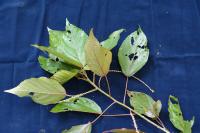
n. shrub to 2. 5 m tall, 1 cm dbh (collection: Michael J. Balick #4856)
Example: When a person gets burned by a fire, take the leaves, squeeze sap on the burn, and then rub a handful of leaves on the burn; use a larger amount of leaves if the person has a larger burn. Apply it directly after the person is burned. This treatment will stop the burn from blistering. Use once. When a 1 month to 2 year old baby has redness or sores on their tongue and cannot eat properly, and saliva is coming out from their mouth, take the sap of the crushed leaves in a spoon and give it to the baby. Take one teaspoon for a 1-5 month old child and a tablespoon for a 6-24 month old. Give the baby once a day for 2 days. This treatment cleanses out the reddish sores. If a person has a sore that is persistent and stays red and sore for a week or more, take 4 apices of this plant, chew and spit on the sore to help it heal. Use 1x in the morning, and next day in the afternoon. Use 2x only. If a person is walking in the bush and concerned about evil spirits, put a small branch behind the ear to be safe. To treat hot chest pain, dizziness, shortage of breath, and if a person has a hot pain that does not go away after taking panadol (aspirin), take 8 leaves and squeeze into a glass of water until it turns reddish, drink 1x a day for 3 days; this is said to make the pain go away.
bookmarknegrecreipek
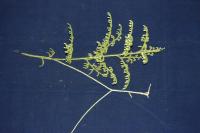
nejecjec
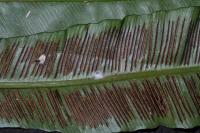
nejeg
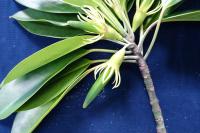
n. tree to 4 m, dbh 8 cm (collection: Michael J. Balick #4925)
Example: The wood of this tree is hard and used for house posts. It grows in the water or inundated areas, fish, crabs, sea creatures use the roots of this tree to hide and breed. People know that this tree stops big waves and therefore protect the trees.
bookmarknejev
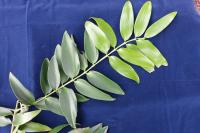
n. tree, 8 m tall (collection: Gregory M. Plunkett #3214)
Example: This tree makes good wood for canoes as well as timbers that are cut for building houses. A decoration that is placed around the head, known as salu-salu is made from these leaves. If you wear it, people know you are from Aneityum. In the early 1950’s-1960’s, Aneityum was the main place for logging this species. Now it is rare and in need of replanting. A project from New Zealand planted pine trees in its place and they have thrived here. In the same way, the sandalwood tree was overharvested and is rare now. Timber, very resinous so good to start fire – branches good for fire. They are the ones that have the sap, if a person in in the bush and finds young tree – sapling – they will make headdress from the leaves to show they came from the bush. Also, this is a Kastom name.
bookmarknejoplec
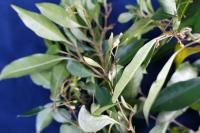
nelm̃ae

n. small tree. Found in the village, but not cultivated. (collection: Ashley A McGuigan #17)
Example: 1. Ancestors used this plant to make fish line – cut young branches, remove outer bark and tie together, put in salt water or fresh water for a week, it is now strong, dry in sun, take fibers and twist them together to make a very long fishing line. 2. Leaves are used to feed pigs. 3. Take inner bark, scrape it and put on boils. Attach with any leaf and it takes out the boil. 4. Trunk for temporary bush house.
bookmarknepilvan
n. tender shoots
bookmarknepnai
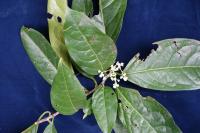
n. tree to 5 m, flowers white. Growing in secondary forest with metroxylon palms and other large trees. (collection: Michael J. Balick #4954)
Example: The pear shaped fruits are eaten when ripe. Peel off the outer skin, eat inner part and discard the seed. The leaves are used to protect food as it is being cooked on an earth oven. To prepare the oven, pile hot stones, then put a layer of leaves on the stones, and then place hot stones on top of the leaves. To make a hot oven, the stones are lined in a pit, a fire lit, more stones placed on firewood and the top layer of stones gets very hot. Then, remove the stones from the top of the wood, and cook food o the bottom layer of stones, add a layer of leaves, place the food on top of this, then cover with a layer of leaves and then pile the rest of the hot stones on top of the leaves.
bookmarknese
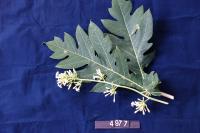
n. herb to 4 m tall, male flowers white (collection: Michael J. Balick #4977)
Example: The fruits are edible and eaten when ripe. To soften beef or octopus, or other meat that is tough, chop green fruit and put in a bowl with meat/fish and then add some water. Allow to sit for 30 minutes or if the food needs to be softer, then leave it in longer. The leaves are used to feed lobsters that are being kept in cages underwater, following their harvest. The leaves are used to cover stones on the earth oven. To treat a person with Ciguatera illness, wash many very gren fruits of papaya, the smallest ones that form at the top, and eat these to help relieve symptoms.
bookmarknesgin
n. the pith
bookmarkneyo
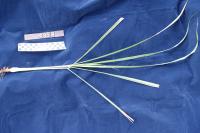
n. grass to 70 cm tall, sterile. Cultivated at the side of a field. (collection: Michael J. Balick #4958)
Example: The leaves and stems are boiled in water to make tea. The base of the leaves (the whitish part) is used to cook foods that have a strong odor, such as goat or shark. The base is sliced and put in the soup and this helps to keep the smell of the goat or shark from infusing through the rest of the food and making it less palatable. In some areas of Aneityum, such as in cassava fields, there is a fungus that kills the crops. This species is interplanted with the crops to kill that fungus and protect the crop plants.
bookmarknidin
n. sap
bookmarknidintaueuc
n. new coconut leaves
bookmarknidwunitei
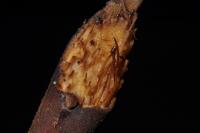
n. tree fern, trunk 2 m tall (collection: Gregory M. Plunkett #4102)
Example: 1. There are kinds of this plant. This is considered the white one. See GMP #4100, Cyathea sp., which is considered the black one.
bookmarknigie

n. shrub, 1. 5 m tall (collection: Gregory M. Plunkett #3537)
Example: This plant is an aphrodisiac. Eat with coconut meat to make the body strong. Take 1/2 handful of leaves and mix with coconut leaves, use as needed. Mostly men eat this combination. It is best to eat with dry coconut that has no water in it. Eat it any time you wish.
bookmarknigirid
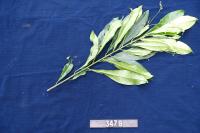
n. tree, 2 m tall (collection: Gregory M. Plunkett #3479)
Example: The leaves of this plant are used in cooking, particuarly with the earth oven. Use a fire to heat stones, then when the fire burns down and the stones are hot, pile these leaves on top of the hot stones and then place the food being cooked--taro, fish, pig, cassava, banana or other foods--on top of the leaves. Then pile more of these leaves on top of the food and then place additional hot stones on top of that pile of leaves. While the food is cooking--each type of food takes a different amount of time--the leaves give off a very nice smell and help flavor the food. The young stems of this plant are used in home construction but as they are small and thin, they are not used for posts.
bookmarknilec
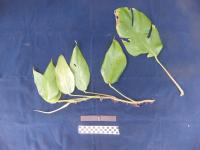
n. epiphyte. Growing on tree in village area. (collection: Ashley A McGuigan #1)
Example: Makes period normal again. Take three young leaves from the very tops of the plant and pound and squeeze out the juice from the leaves. Mix with small amount of water to help juice come out. Drink this 3 times a day for 3 days. Pig food – feed the leaves to the pigs. Leaves used to wrap around Cyrtosperma merkusii to cook for several days—this taro needs a lot of cooking. So this leaf is particularly used for that purpose because it is very watery. Will keep the taro from becoming too burned or dry – it will cook soft after a few days – keep tasting it until the calcium oxalate sensation is gone. Check it 3 times – cook, open, taste and it should be good. Wrap fish and put directly on charcoal fire. – also cover top rocks in earth oven.
bookmarknilpudou
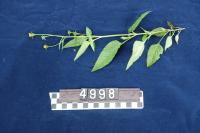
n. herb to 70 cm, florets yellow (collection: Michael J. Balick #4998)
Example: To treat a headache, especially from the flu, boil a handful of leaves in 1 liter of water for a few minutes, let cool and drink 1 cup of liquid per day . Also can treat this type of headache by using the plant in a steam bath, by boiling 4 handfuls of leaves in a pot of water, covering the head with a towel and breathing in the steam from the pot.
bookmarknisyeg
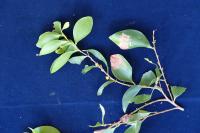
n. tree, 6 m tall (collection: Gregory M. Plunkett #3574)
Example: 1. The inner bark of this plant is used as a dye or paint to provide a brown color. Boil the inner bark in a pot with a shirt and the color of the shirt will be changed to brown. 2. For toothache, people take the inner bark and mix it with sea water, and then rinse the tooth with this mixture to remove the pain. 3a. People macerate the leaves and the bark and when the tide is low, spread this in a pool of water to poison the sea shells that are edible. When they die, the eyes of this organism comes above the sand, indicating where they are, and people harvest and eat them. 3b. To attract and collect clam – NIPJINUMU – scrape bark in a pool of sea water where the clams are attracted immediately and can be collected, coming up from the sand. 4. Firewood, unspecified medical use.
bookmarknititan
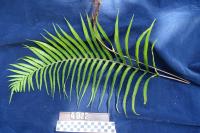
n. fern to 0. 75 m, sori brown. growing along trail. (collection: Michael J. Balick #4972)
Example: The fronds of this fern are used to wrap sting ray and shark meat, which have a great deal of moisture in them, for cooking on the earth overn. Wrap the fronds (leaves) around the meat and tie with a Pandanus string. Because they are not thick, broad, entire leaves, but rather have many places in them where water can drain out during the cooking process, it is said that these leaves are much better for preparing these two types of fish, as well as any other meat that contains a great deal of moisture. For cooking on the earth over, put these wrapped foods on top of any other leaves so that they do not touch the hot stones directly, and then cover with other leaves as well. Then place the hot stones on top of these wrapped meats.
bookmarkniyeg
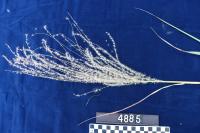
n. grass to 1. 5-2. 0 m tall, inflorescence white. Red clay soil (collection: Michael J. Balick #4885)
Example: Cut this grass in the morning, let dry for 2 days, and then use to weave the roof of a house. This is thicker and heavier than a coconut leaf. Also, use for cyclone house. (see photos of house) When indicating something is Tabu, tie the leaf and put it in an object like ripe bananas and people know it is Tabu and will not take it away.
bookmarknumujced
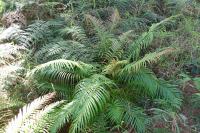
n. fern to 0. 75 m, sori brown. Growing in pine forest. (collection: Michael J. Balick #4983)
Example: Join two of the inrolled fronds together at the part where the frond is opening (the tip that is curled) such that the leaves are held together by their unfolding growing tips. Place this along the path that is frequented by a wild pig (they travel along paths) and when the pig passes these two leaves, and is chased by a hunter’s dogs, these leaves in this formation are said to sap some of the pig’s energy and thus allow the dogs to catch up with it. This was explained to Tony by another person who mentioned it as a sort of magical power possessed by this type of fern.
bookmarknupunyepec

nuput, noho’ich

n. cultivated anthropogenic landscape (lawn and planted trees). (collection: Keith E. Clancy #6655)
bookmarknup̃ut
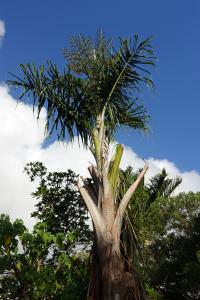
nyihivac
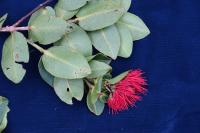
n. tree, 6 m tall (collection: Gregory M. Plunkett #3263)
Example: 1. A "calendar plant". When this flowers in the bush, and people are making their gardens in that area, it means the garden is ready to harvest. 2. Firewood, calendar, and message plant – for people who live up in the forest can see this coastal plant and when it flowers it is a good time to go fishing or to move to the coastal area for a few weeks to relax. July-August. Tide is low so everything is exposed so it is a good time to fish for there, 2 months. 3. Flowers have a nice nectar, sweet, kids drink.
bookmarkpassion fruit
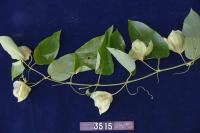
n. liana climbing on broken mango tree, growing in forest at edge of wide tidal stream (collection: Gregory M. Plunkett #3515)
Example: 1. The ripe fruit of this plant is edible. It was introduced to the island and is considered a foreign vine. 2. 4 leaves of this and 4 leaves of Annona muricata and boil in water and let get warm and wash children when they have measles and fever. Edible fruit – very sweet.
bookmarktesyapotan
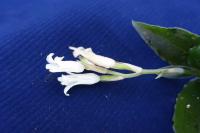
n. terrestrial orchid growing in cloud forest along ridge. Flowers white. (collection: Gregory M. Plunkett #3281)
bookmark